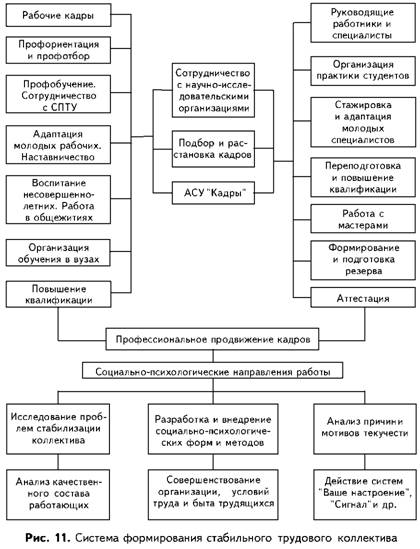home
 Management Management
 Theory and practice of personnel management - Shchekin GV Theory and practice of personnel management - Shchekin GV
|
Theory and practice of personnel management - Shchekin GV
14.3. Adaptation of young workers and improvement of the socio-psychological climate in the workplace
Improving the organization of industrial and social adaptation of workers, especially young people, is very important for reducing the turnover of workers in production, where up to 50% of all workers are under the age of 30, and the level of turnover among them is twice as high as that of workers of other age groups , And is almost 2/3 of the total staff turnover. The level of fluidity among young people is determined by the formula:

Where K m - the coefficient of turnover of staff among young workers (up to 30 years) with work experience at the enterprise to two years;
PM - the number of young workers with an experience of work up to two years, retired for reasons of turnover;
P fm - the actual number of young workers with an experience of work at the enterprise up to two years for the relevant period.
The coefficient of turnover of young workers is similarly calculated for each interest group (professional, in terms of work experience, in structural units, etc.).
An important role in optimizing the processes of social and industrial adaptation of employees belongs to the mentoring movement. To each newly admitted young worker it is necessary in 3-5 days to attach a mentor from among highly skilled workers who have the capacity for educational work. Control over the passage of adaptation is carried out by the personnel services in conjunction with the advice of the mentors of the enterprise.
One of the factors that have a significant impact on the processes of fluidity is the socio-production climate of the relationship, which can be conditionally represented in the form of three "climatic zones":
I "climatic zone" is a social climate determined by the degree of awareness by each employee of the overall goals and objectives of the organization (enterprise) and formed under the influence of: a personal example of management personnel in the passion of the business; Strict observance of legal and moral norms; The development of democratic principles in the management of production;
II "climatic zone" is a moral climate determined by moral values acting in the community and is local in scope, that is, characteristic of the primary collective: the brigade, the section, the department;
III "climatic zone" is a psychological climate, the peculiarity of which is that it is formed between workers who are directly in contact with each other.
In teams with an unhealthy moral and psychological climate, labor productivity is low and the staff turnover is high. Young workers and women are especially sensitive to the moral and psychological atmosphere. The growth of labor productivity, conditioned by the good mood of employees, can reach 5-10% of the average level. And, conversely, a bad mood reduces labor productivity by the same amount. Consequently, only on the mood of the employee labor productivity can vary by 10-20%. The creation of a normal moral and psychological climate is facilitated by the introduction of functional music, which ensures a 2-4% increase in labor productivity and a 6-8% decrease in marriage, and also contributes to an increase in the general working culture, a decrease in staff turnover, a reduction in morbidity,
An important factor in the formation of a healthy climate in the workforce is the introduction of various sociological and socio-psychological procedures, as well as improving the style and methods of leadership, relationships in production.
In general, the system for the formation of a stable work collective (schematically shown in Fig. 11) provides for the constant and purposeful work with various categories of workers aimed at increasing the workers' satisfaction with work, improving cultural and living conditions, improving education and the education system, improving skills and professional advancement Working.



Comments
When commenting on, remember that the content and tone of your message can hurt the feelings of real people, show respect and tolerance to your interlocutors even if you do not share their opinion, your behavior in the conditions of freedom of expression and anonymity provided by the Internet, changes Not only virtual, but also the real world. All comments are hidden from the index, spam is controlled.